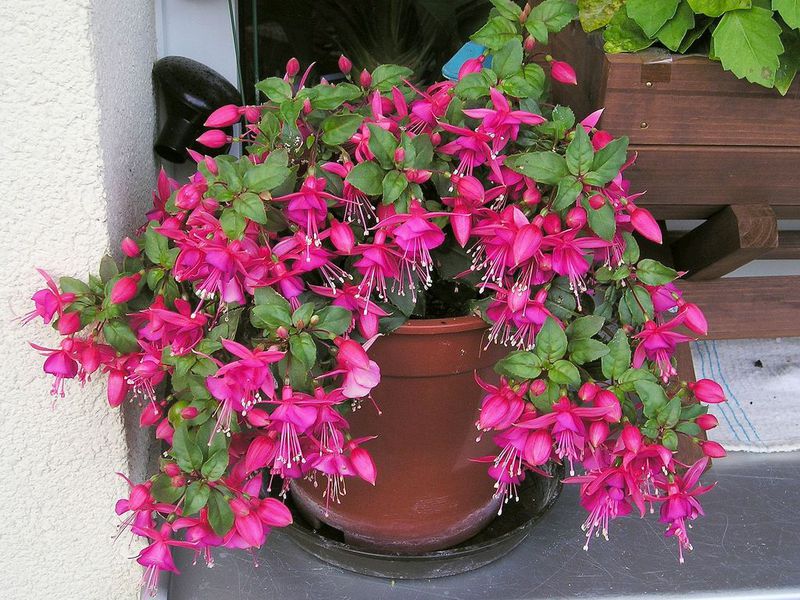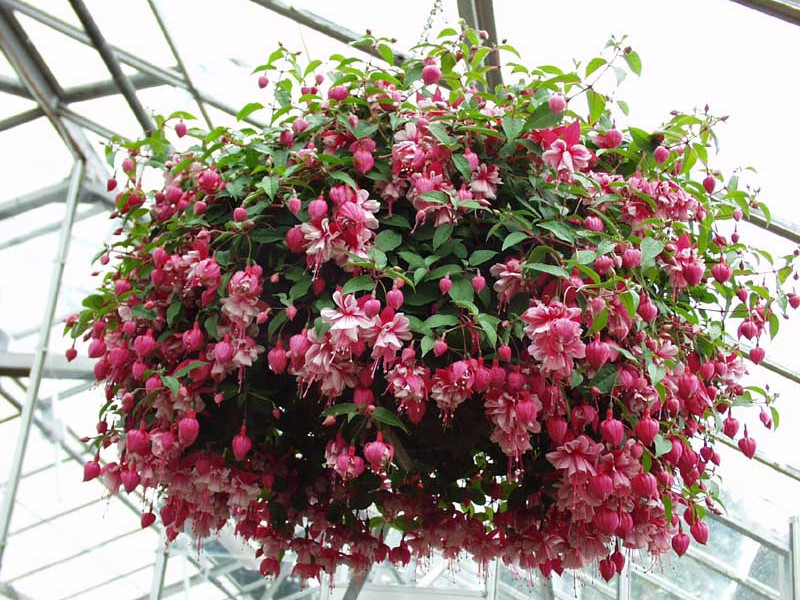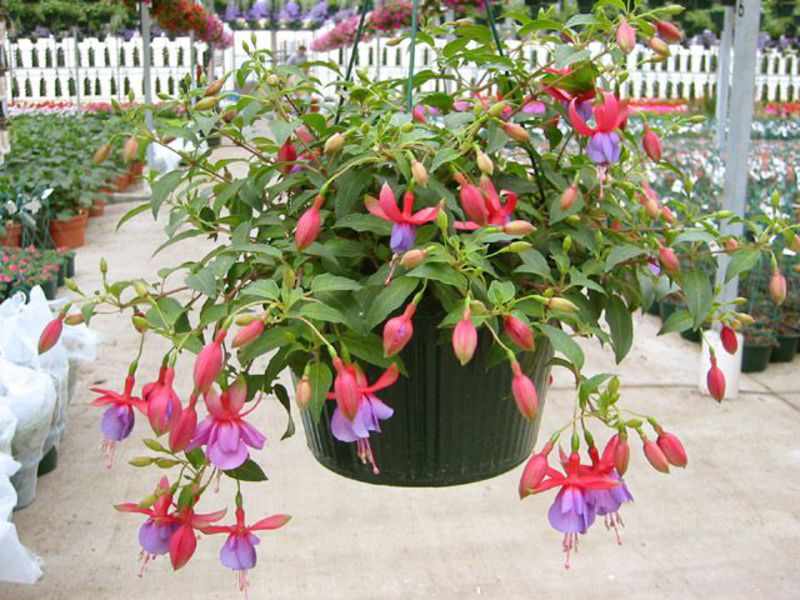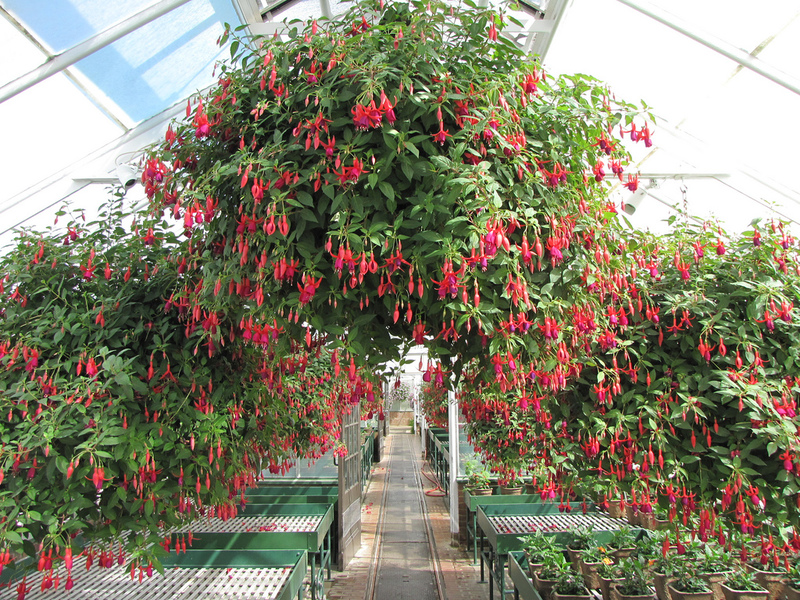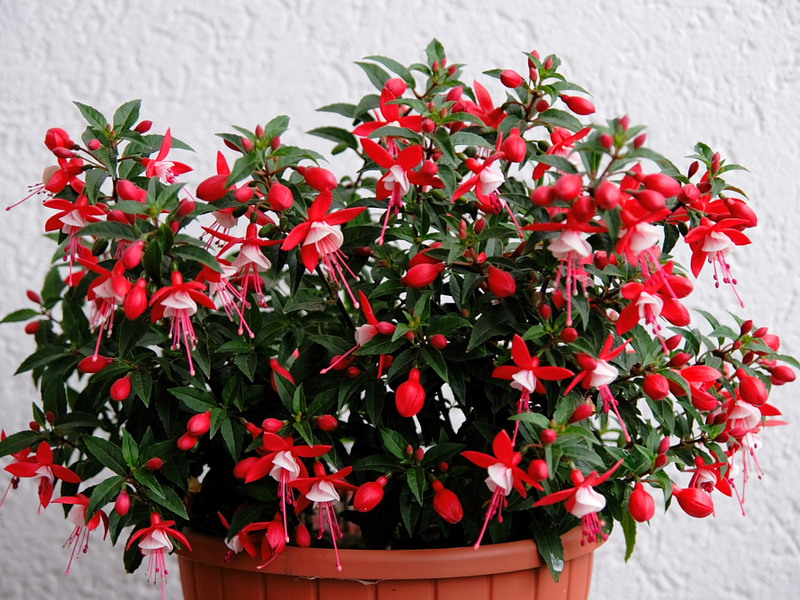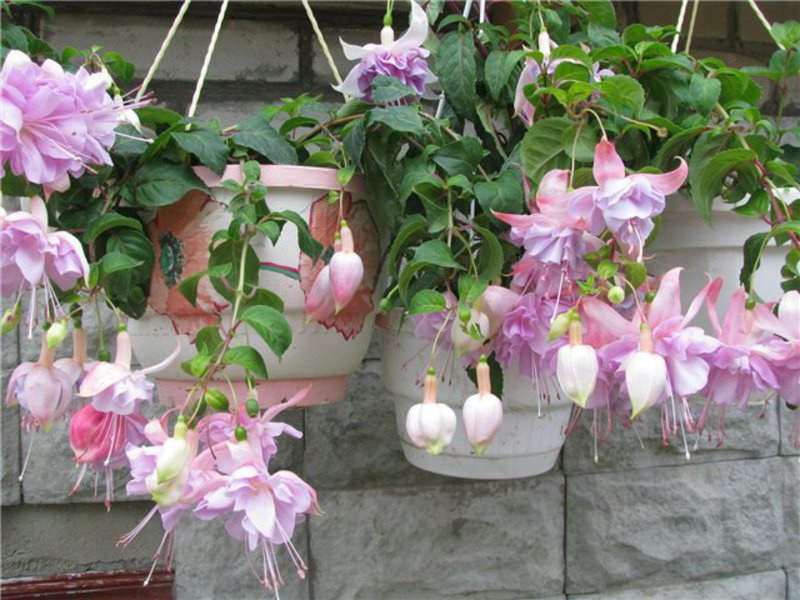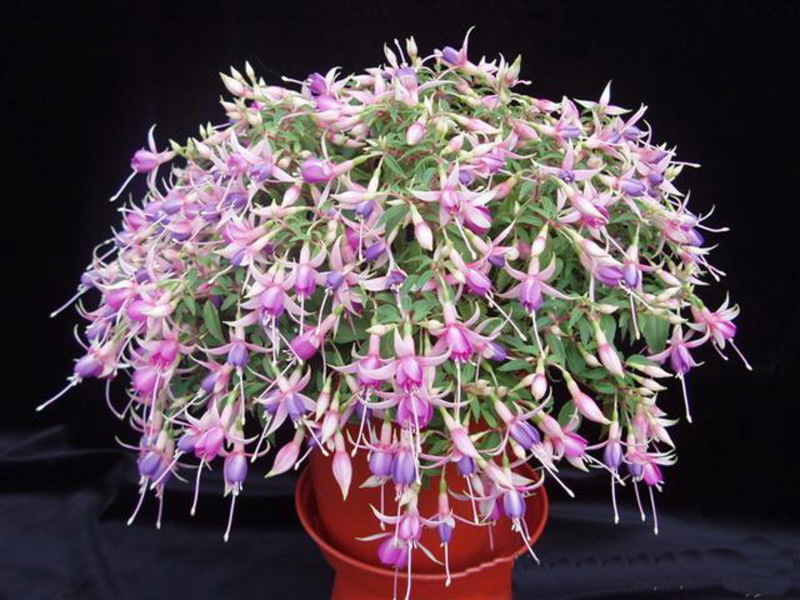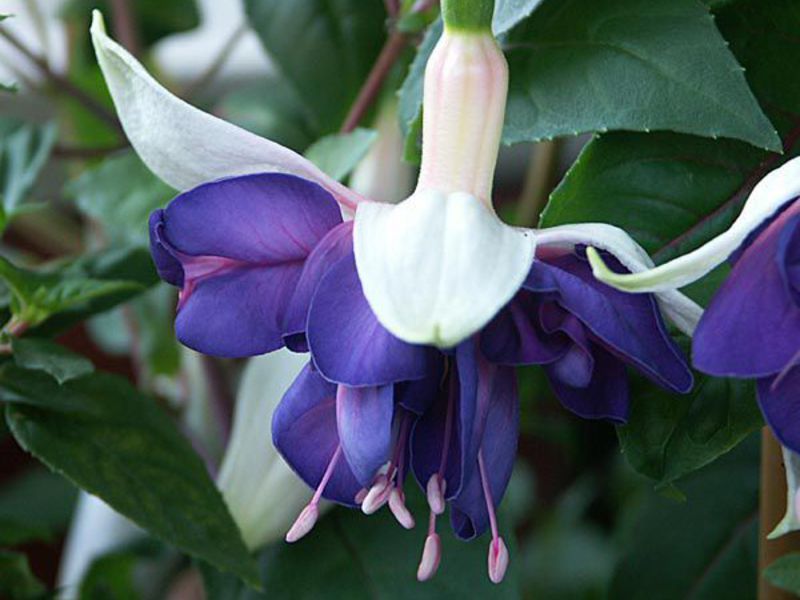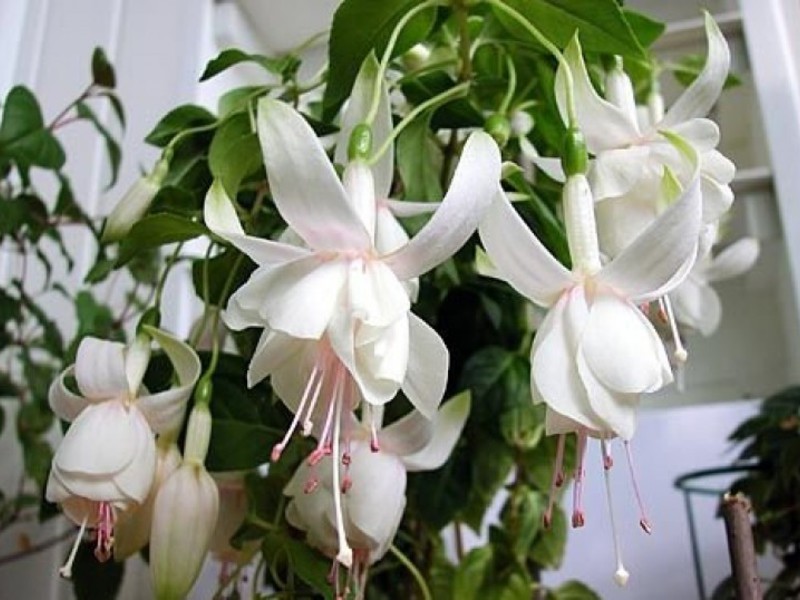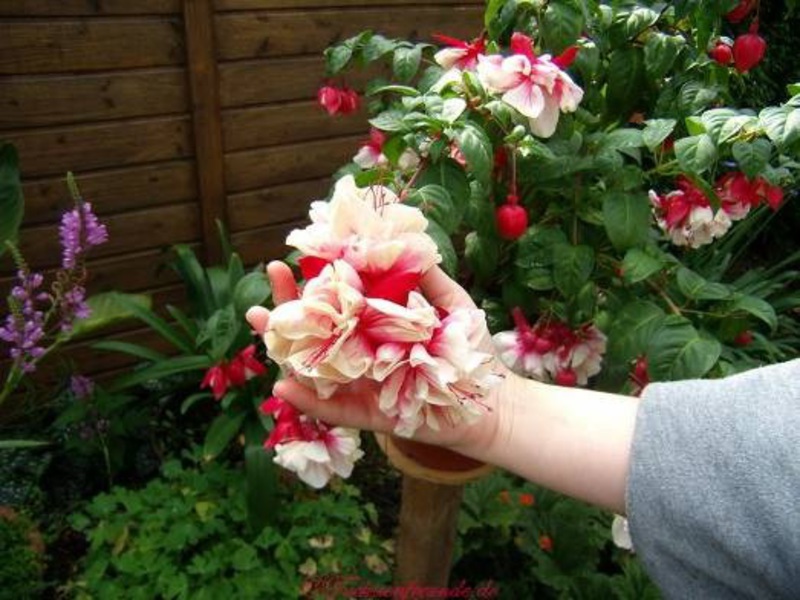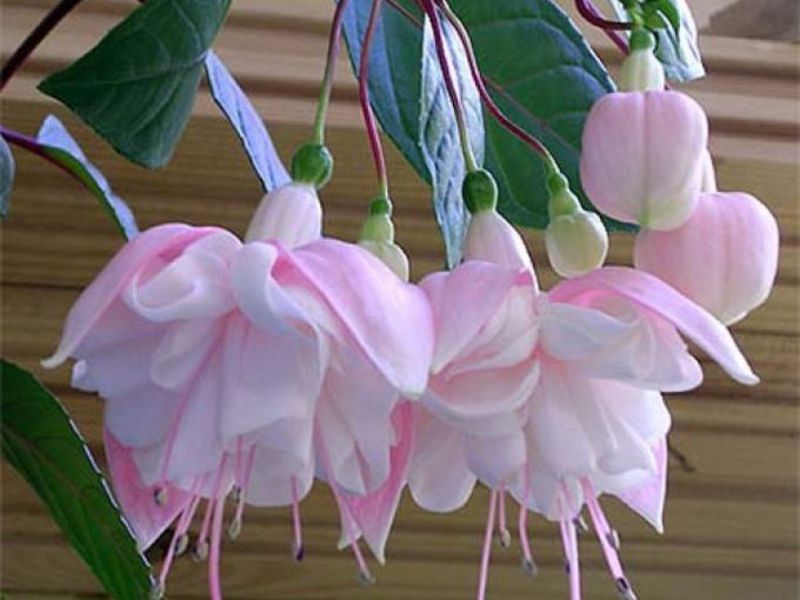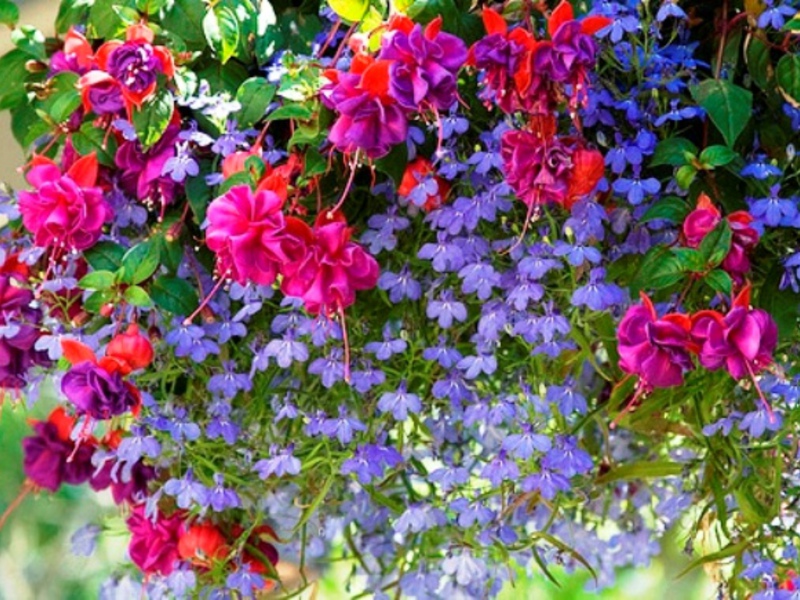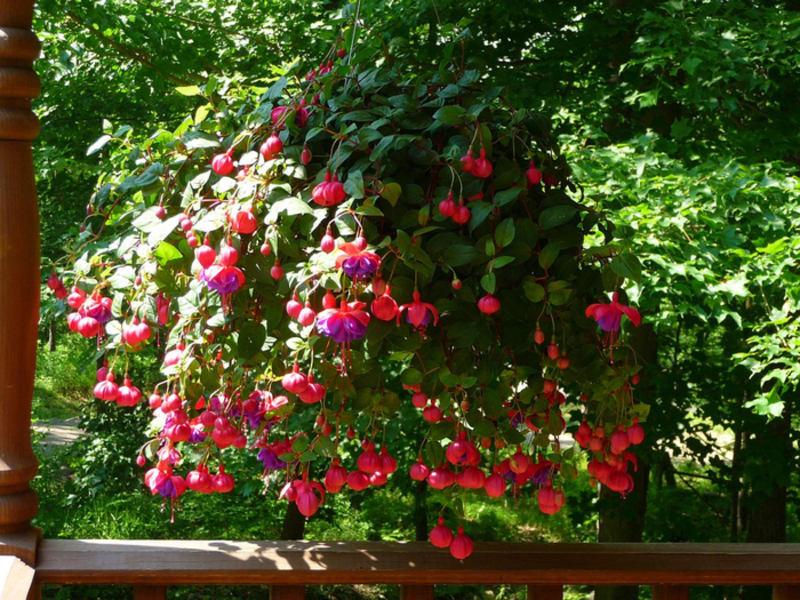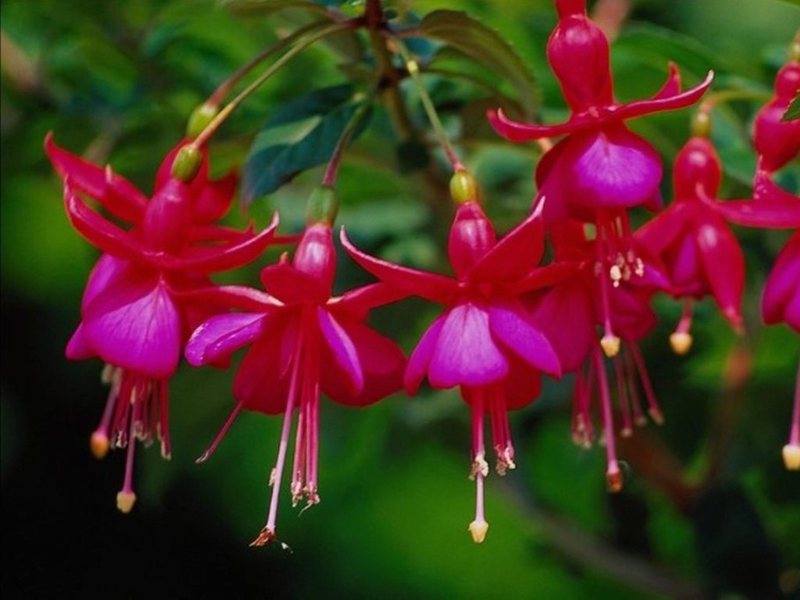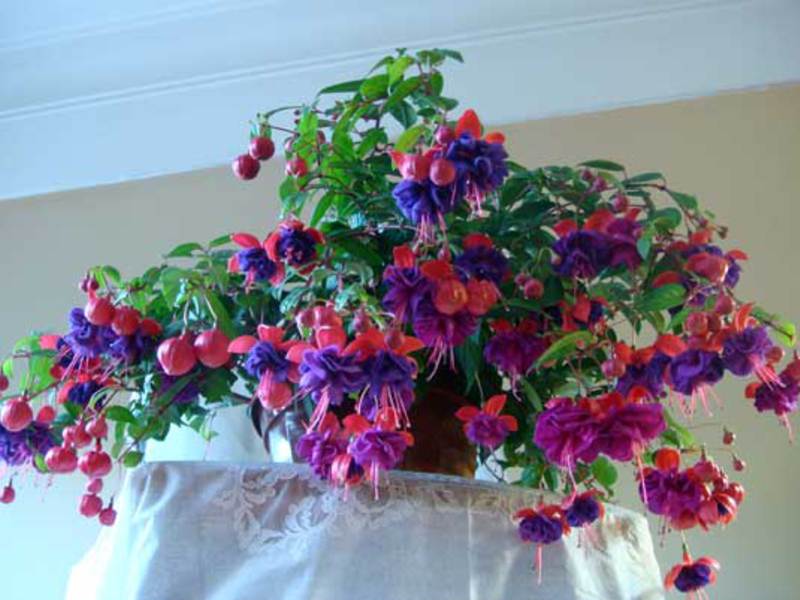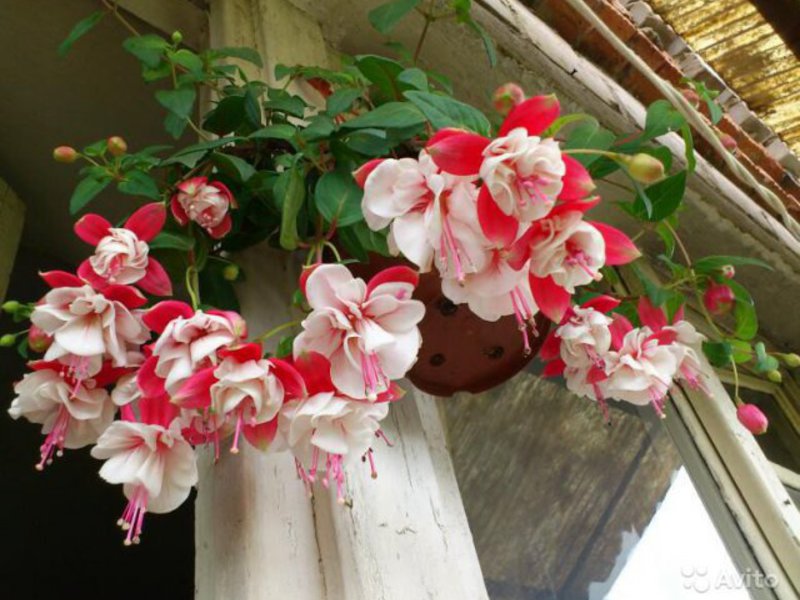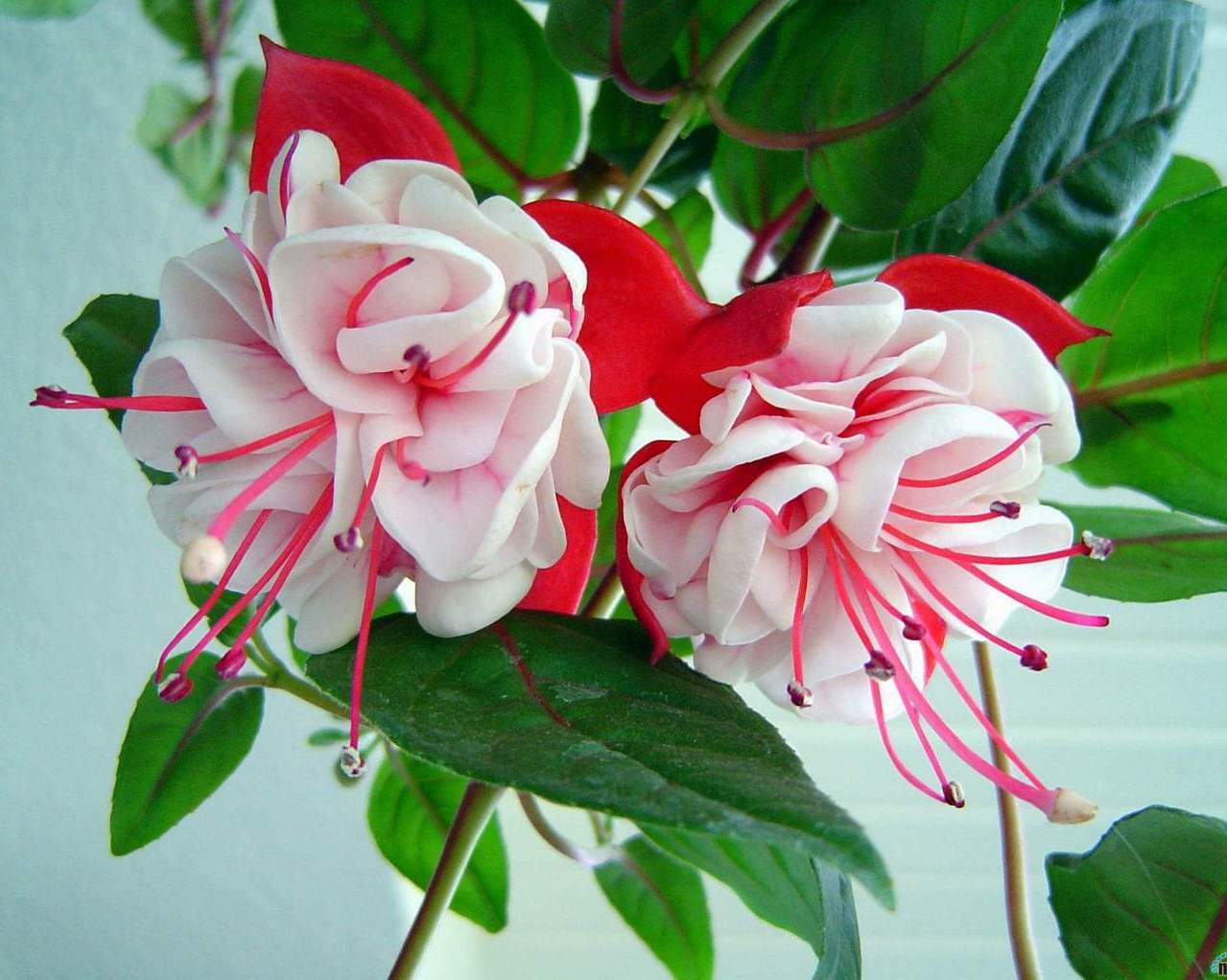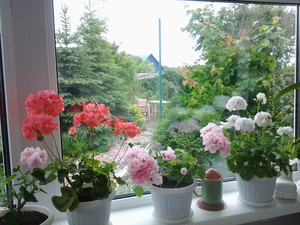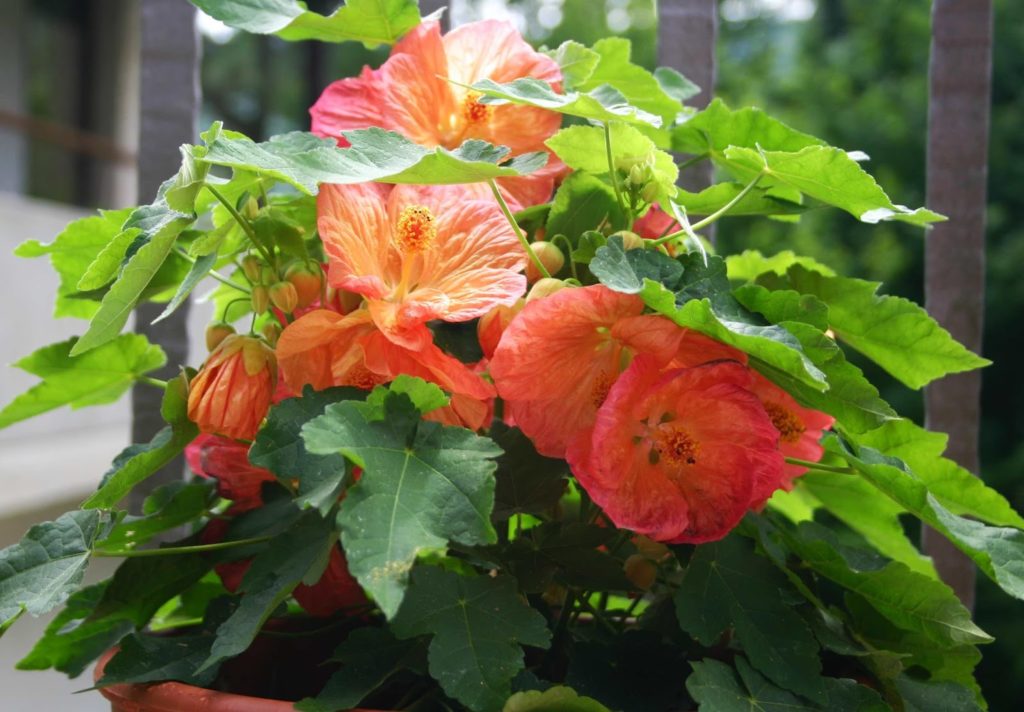Experienced growers are probably familiar with a plant like fuchsia. Of the features of this flower, it is worth highlighting its graceful appearance, as well as a long flowering period. However, for many, this plant is interesting for its unpretentiousness, therefore, if you have planting material, you can even grow fuchsia without special knowledge, ready to please the owner with bright flowers.
Content
Description, main varieties and types
Depending on the characteristics, fuchsia can be in the form of an ampelous plant, a shrub or a short tree. In the process of development forms flexible shootsthat provide a falling crown. The leaves are small in size and reach a length of 5 cm, the characteristic color is bright green, oval in shape, there is a pointed end at the end.
Fuchsia can have flowers in different shades, ranging from white and pink to blue and purple. Some of them are quite amazing in their form: in the form of bells or dancing ballerinas. Such a pronounced decorativeness is explained by the unusual structure of the flower. The petals are formed from a tubular rim and, at the stage of full opening, form fluffy skirts that resemble a group of dancers. The long stamens that complement them are very similar to slender legs dressed in pointe shoes.
Popular varieties
The wide species diversity of this plant did not go unnoticed by breeders, and subsequently they served as the basis for breeding new varieties and hybrids. For domestic cultivation, mainly hybrid forms are intended. Depending on the height the following types of fuchsias are distinguished:
- bush. They have smooth shoots that are facing up;
- ampelous. Form flexible stems that are flowing down;
- ampel-bush. To give them a characteristic shape, a support is needed so that long stems can be tied to it.
Within the framework of bush fuchsias, the following varieties can be distinguished, which most often used for growing in floor containers:
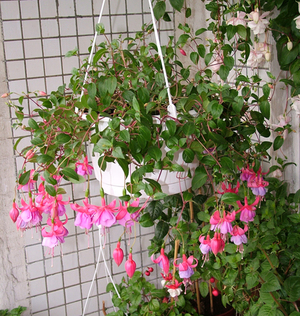 Armbro Campbell. This variety is distinguished by its unpretentiousness and the minimum time required for rooting. Flowering begins in winter: at this time of the year, large double flowers are formed, decorated with narrow leaves and pale pink petals;
Armbro Campbell. This variety is distinguished by its unpretentiousness and the minimum time required for rooting. Flowering begins in winter: at this time of the year, large double flowers are formed, decorated with narrow leaves and pale pink petals;- Alisson Bell. The decorative properties of this variety are associated with its semi-double purple-reddish flowers;
- Annabelle. During flowering, large double white flowers are formed. Within this variety, ampel type plants are available;
- Henriett Ernst. Scarlet sepals, which are decorated with a light lilac skirt, give originality to this variety;
- Waist. This fuchsia variety produces bright orange flowers.
Many growers often choose to grow at home and ampelous fuchsia varieties... The latter draw attention to themselves by curling and hanging from hanging baskets and flowerpots. The most popular ones are the following:
- Hollis Beauty.During flowering, double white-pink flowers are formed;
- Prince of Peace. This variety is adorned with flowers formed by white sepals and a red skirt;
- Blue Angel. The originality of this variety is given by flowers with a lilac-purple color, which is effectively complemented by white sepals;
- Imperial Crown. Forms flowers of scarlet color, having an elongated shape, which are presented in the form of brushes.
Plant care at home
The habitat of this plant is South America and New Zealandwhere it grows in conditions of high humidity. Accordingly, the same care must be provided for fuchsias in a city apartment, for which it is necessary to carry out regular spraying. Transplanting and pruning is mandatory for the normal development of a perennial. Fuchsia is sensitive to lighting, so moving a flower pot to another place or even turning it can greatly affect its development.
Fuchsia transplant
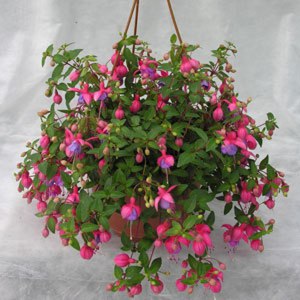 If fuchsia was purchased in a pot with enough space for growth, then transplanting is not required. If everything points to the opposite, then it is recommended to find more spacious container... It is best to transplant fuchsia into a light container. Due to the improved reflectivity of such a capacity, the plant will be protected from overheating.
If fuchsia was purchased in a pot with enough space for growth, then transplanting is not required. If everything points to the opposite, then it is recommended to find more spacious container... It is best to transplant fuchsia into a light container. Due to the improved reflectivity of such a capacity, the plant will be protected from overheating.
In the future, the plant should be transplanted annually. Before performing this operation, preparatory measures must be taken:
- preventive and stimulating pruning. Healthy shoots are cut by one third, and old, dry and too elongated ones must be completely removed;
- checking the condition of the rhizome. According to its results, it is possible to understand whether the plant has signs of disease or decay. Identified affected areas must be trimmed to healthy tissue;
- placing drainage in a container prepared for transplantation. It is recommended that it occupy at least 1/5 of the height of the pot.
After planting fuchsia, it is necessary well water and spray... Feeding can be done only three weeks after transplantation.
Soil composition and soil fertilization
Fuchsia can grow in almost any soil. Therefore, before transplanting, the pot can be filled with a universal earthy mixture for indoor plants. However, the plant will feel best in the soil of a loose structure, for which it does not hurt to add sand, peat or ash to it. If you plan to independently prepare the soil mixture for transplanting, then you can include the following components:
- leafy soil, peat, sand (in a ratio of 3: 2: 1);
- sod land, humus, peat, compost (2: 1: 1: 1).
When the plant begins to grow after transplanting, as well as during flowering, it is necessary to fertilize with mineral complex fertilizers once a week. These can be drugs such as "Kemir", "Effekton", "Pocon for geraniums". For the first time, fertilizers are applied to the soil in March. Their number is gradually increasing. With the approach of autumn, the amount of applied fertilizers is reduced, and in winter they must be completely eliminated.
Fuchsia pruning
 It is necessary to prune ampelous fuchsia during the entire growing season. Without this, it is impossible to create favorable conditions for normal growth and abundant flowering. The first time fuchsia is necessary pinch after rooting the cutting... In the future, it should be pruned throughout the spring before entering the flowering phase. In summer, you need to pay attention to the longest shoots that will bloom in the fall.
It is necessary to prune ampelous fuchsia during the entire growing season. Without this, it is impossible to create favorable conditions for normal growth and abundant flowering. The first time fuchsia is necessary pinch after rooting the cutting... In the future, it should be pruned throughout the spring before entering the flowering phase. In summer, you need to pay attention to the longest shoots that will bloom in the fall.
To create a beautiful crown, it is necessary to trim the side shoots located above each 2-4 pair of leaves. As a result of this procedure, the plant will be able to acquire a standard shape. But this is possible only if there is a support to which the central shoot will have to be tied, while the side branches must be removed.
Watering and lighting
The plant grows and develops well if it is watered in moderation. During the entire growing season, it is necessary to maintain optimal soil moisture in the pot, but at the same time the water in it should not stagnate. When leaving, after the next watering, you must wait 15 minutes, and then drain the remaining waterformed in the pallet. With the onset of autumn, the number of waterings is reduced to 1-2 times a month. Fuchsia does not need to be watered in winter.
To create the most favorable conditions for plant development, it is desirable to maintain increased air humidity conditions. For this, in addition to watering, it is necessary to spray the leaves. An effective measure is to place a container filled with water near the pot.
Fuchsia loves a moderate thermal regime, and also responds well to diffused lighting. However, it does not tolerate shading. It is advisable to place the flower pot on the balcony or on the west or east side, where it will be provided with sunlight in the morning or evening.
Optimum temperature
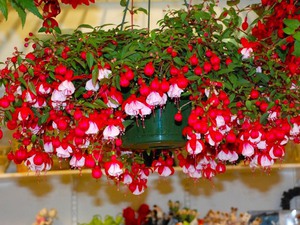 In order for fuchsia not only to grow well, but also to form many inflorescences, it must be provided appropriate temperature conditions... A favorable temperature for it is + 20 .. + 22 degrees Celsius during the day and + 16… + 18 degrees Celsius at night. If the ambient temperature is higher than recommended, then the gardener runs the risk of not waiting for flowering, and may also face such an unpleasant phenomenon as dropping leaves. On especially hot days, the plant requires additional moisture, for which it is recommended to spray with settled cool water.
In order for fuchsia not only to grow well, but also to form many inflorescences, it must be provided appropriate temperature conditions... A favorable temperature for it is + 20 .. + 22 degrees Celsius during the day and + 16… + 18 degrees Celsius at night. If the ambient temperature is higher than recommended, then the gardener runs the risk of not waiting for flowering, and may also face such an unpleasant phenomenon as dropping leaves. On especially hot days, the plant requires additional moisture, for which it is recommended to spray with settled cool water.
Fuchsia starts to feel bad even with good care, if the temperature does not reach the recommended level. Therefore, in winter, to protect from cold weather, it is recommended to put foam or a wooden board under the pot.
Fuchsia propagation
If you want this perennial to produce many flowers every season, then you need to provide it with proper care. If such a need arises from it, you can get and planting material for propagation... There are many opportunities for this, since young plants can be obtained both from seeds and from cuttings and leaves.
Seed propagation
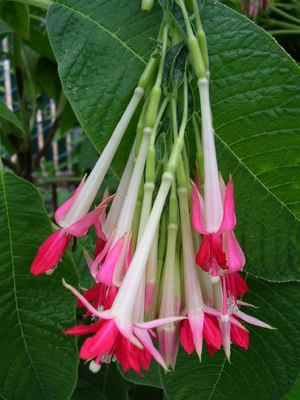 If you decide to get new fuchsia seedlings from seeds at home, then keep in mind that this process will take a lot of time and effort. The first step is to stock up on quality seeds. To do this, you need to constantly monitor the state of the mother plant, avoiding self-pollination of his flower... This can be done by carrying out the following activities:
If you decide to get new fuchsia seedlings from seeds at home, then keep in mind that this process will take a lot of time and effort. The first step is to stock up on quality seeds. To do this, you need to constantly monitor the state of the mother plant, avoiding self-pollination of his flower... This can be done by carrying out the following activities:
- removal of anthers from a recently opened flower;
- the transfer of the pollen of the parent plant on the stigma;
- protection of flowers after pollination by covering with a cloth or paper bag.
After a couple of weeks, the fetus reaches maturity. After opening it, the seeds are taken out and allowed to dry for several days. For planting, use shallow containers filled with a moist substrate. Seeds should be placed on the soil surface.
After sowing, the seed bowls must be transferred to the greenhouse, where the optimum temperature and good lighting must be created. After 10-15 days, seed germination... After another 1.5 months, the time comes for picking the seedlings. Subsequently, young seedlings are hardened, for which they need to be taken out into fresh air for some time. For the first time, hardening should be small - no more than 15 minutes, but later the residence time of the seedlings is increased. After another two months, the seedlings are transplanted into separate pots.
Conclusion
Fuchsia is deservedly popular among many flower growers. Such an increased interest in it is primarily due to its unpretentiousness. Not to mention that it blooms very profusely, and if necessary, it can be propagated without much difficulty... However, as is the case with other indoor plants, you can propagate fuchsia at home only if you take the necessary measures. Therefore, if you properly prepare the flower itself, select the soil that is optimal in composition, and create favorable conditions for rooting and growth, then you can count on the fact that fuchsia will quickly take root and very soon begin to bloom profusely.
